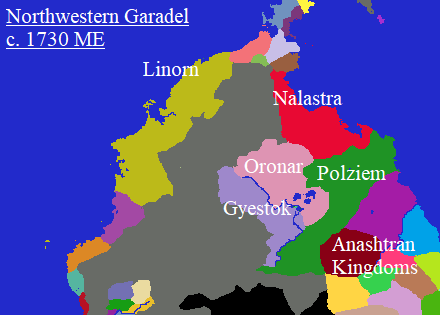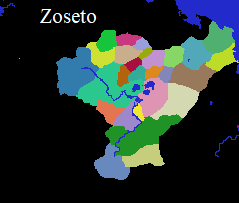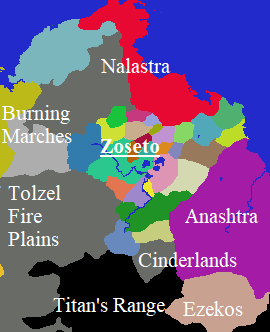Early Zosetan History
Zoseto has been a center for semi-nomadic agriculture and herding for millennia. Had it not been for the creation of the
Tolzel Fire Plains in the late Divine Era, Zoseto likely would have been on track to being a major regional power - but as it happened, the tribes of Zoseto were forced to adapt to a new hyper-active ecosystem. After a few centuries of chaos, Zoseto's ecosystem and cultures adapted to the new rhythm and began recovering, but the nearby fire plains always provided a destabilizing factor for any regime that go too large in the region. So, instead, Zoseto's countryside kept to semi-nomadic living and its lake areas gathered into city-state-like microstates. The forests of the region were curated into fire-resistant food forests, the people of the region learned to balance war and trade to best live next to such a large population of horse nomads, and life entered a slow, stable rhythm.
Small interruptions did occur now and then. A migration from the far East in the 300s ME brought new crops and technologies; merchants and loremasters from the rising
Kingdom of Ezekos brought increased trade and archivist-cults in the late 600s; a nomadic empire known as the
Mizram conquered Zoseto and brought a version of
Zihari religion from 815 before it collapsed and the status quo resumed in 980. The closest a group came to trying to enforce settled feudalism was the brief attempt by the Sacred Empire of
the Quenta, a religious group devoted to
the Lunar Goddess Hiku that rose and fell during the late 1200s to mid 1300s. Ultimately, the Zosetan way of life proved too resilient to be overturned by any ambitious cult or invasion - it would take systemic changes to life in Northwestern Garadel to change things permanently. And what do you know? A little economic boom, new major trade route, and rising new religion came along to do just that in the 1600s.
The Grand Alliance (1680 to 1860)
Zoseto already had a very large population by the time that the great trade boom began in the early 1600s, and the surge in foreign religious ideas, cultural ideas, technologies, and weaponry began an arms race among the microstates of the lakes almost immediately. New wealth led to more insulated and powerful elites which led to more centralized groups more motivated to conquer. Microstates turned into small kingdoms, though the constant presence of nomadic groups and fiercely independent tribal communities made it difficult for any of them to truly rise as regional powers. But the rise of the
Saraka religion in the 1680s created even wealthier elites with a stronger regional support network, and gave them new ways to negotiate and buy off (and even weaponize) troublesome nomads.
From 1680 to 1730, the twenty small kingdoms of Zoseto fought and were consumed until only 3 great kingdoms remained:
Polziem, Gyestok, and
Oronar. These three kingdoms competed for dominance and waged a few wars between themselves, but seemed willing to cooperate against external threats. They also had significant marriage between their aristocratic families and military elites. All three kingdoms also waged a shared silent war on local communities and extended kinship networks that challenged their authority. They redistributed land to aristocratic elites, enserfed semi-nomadic groups, and broke the land into permanent sedentary parcels. The
Sarakan temple quietly assisted this effort and profited greatly for it.
Through the mid-to-late 1700s, the Arsha (regional over-priest) of Zoseto was particularly involved in binding these kingdoms together and remaking them into sedentary states. Her name was
Dakya Sunbrand, and she has a complicated legacy as a regional cultural hero who was deeply complicit in a number of brutal crackdowns and attacks on local culture. Her primary love in life was architecture, and she was inspired by the unusual styles of the ancient Quenta, the careful and intricate style of the modern Cult of the Sacred Geometry, and the ambitious foreign styles of distant Samvara and Sonev. She funneled a great deal of wealth and manpower into her ambitious cathedrals and public works, and they remain to this day as symbols of Zosetan wealth and culture. The great works attracted merchants, pilgrims, and priests to the cities, and the architects Dakya brought into the region left behind an excellent mason's guild which hires out architects to wealthy patrons throughout Northwestern Garadel to this day.
In the end, the three great kingdoms overestimated their control of the land. In the early 1800s, the three kingdoms entered an alliance to expand their shared reach into both the Fireplains and neighboring
Anashtra. The alliance made many enemies, and were not as capable in conquest as they expected to be. When an expert politician and commander by the name of
Winek Nontor set to work uniting the Anashtran kingdoms in the 1830s, the Zosetan alliance did their best to stop him - and failed. The Anashtrans took back their stolen lands and humiliated the Zosetan aristocrats on the field. And while the Zosetan alliance crumbled and the kingdoms blamed one another for their failures, nomads surged in from the West. The three great kingdoms fell into civil war, decentralized disintegration, and mass desertions. By 1870, three kingdoms had become twenty four. Things slowly stabilized, and the aristocrats and local communities made a variety of compromises.
Modern Zoseto
The late 1800s were a time of peace and recovery. Some places saw skirmishing between local communities and aristocrats, some places saw one group or another seize power, and some places settled into their own special compromises or institutions. These fragmented states were placed under the protection of the Heirophant of Saraka herself, in order to serve as a buffer zone between the militarized Kingdom of Anashtra and the Sacred State of Nalastra to the North (where the Heirophant ruled from). Anashtra bullied the coastal states into allowing Anashtran trade dominance, but it was a far cry from the era of war and conquest that many expected.
In the late 1800s, an eccentric Prism druid from the distant land of
Kakoru moved into Fireplains with her attendants and comrades via the
Selkie trade routes. This druid converted to Saraka and took the name of
Ujraza, or The Reborn, and toured around Tolzel seeking the wisdom of the fire plains. Ujraza and her acolytes were enamored with the curious architecture of Zoseto's cathedrals and she retired to Zoseto permanently in 1899. She and her disciples became known as the
Circle of Wildfires, and expanded their operations significantly in the 1900s and 1910s. For the first half of the 1900s, the Sarakan temple invested heavily in these druids in the hope of creating a robust druidic division of the temple, but the chaotic anti-settlement ideology of the Circle made them harder to control than expected. In the 1950s, the Circle allied with the
Riders of the Free Flame (under threat of invasion, to be fair) against the Heirophant. While the druids and nomads won, many of the other settled states were scared away from making their own druid circles. Now, the Circle is largely contained to Zoseto and the Fire Plains themselves - still highly regarded and even revered by the Temple, but feared as potential agents of chaos.
The friendship between the nomads and the druids proved immensely profitable for the kingdoms of Zoseto. Not only do they have a near-monopoly on Sarakan druids, the druids keep the nomads from raiding and invading! It does mean that expansion into the fireplains is off-limits and
Fire Termite farming is significantly reduced, but Zoseto's forests are rich and populated enough to be successful without those things.
Ever since the victory of the Riders of the Free Flame, Zoseto has been under the political and economic influence of the
Sacred State of Nalastra.






Comments